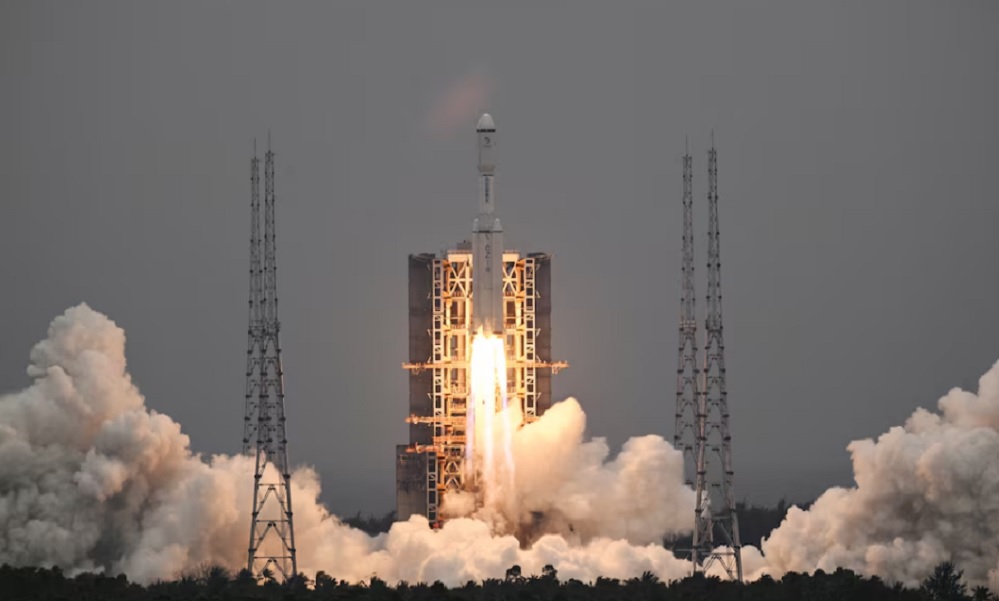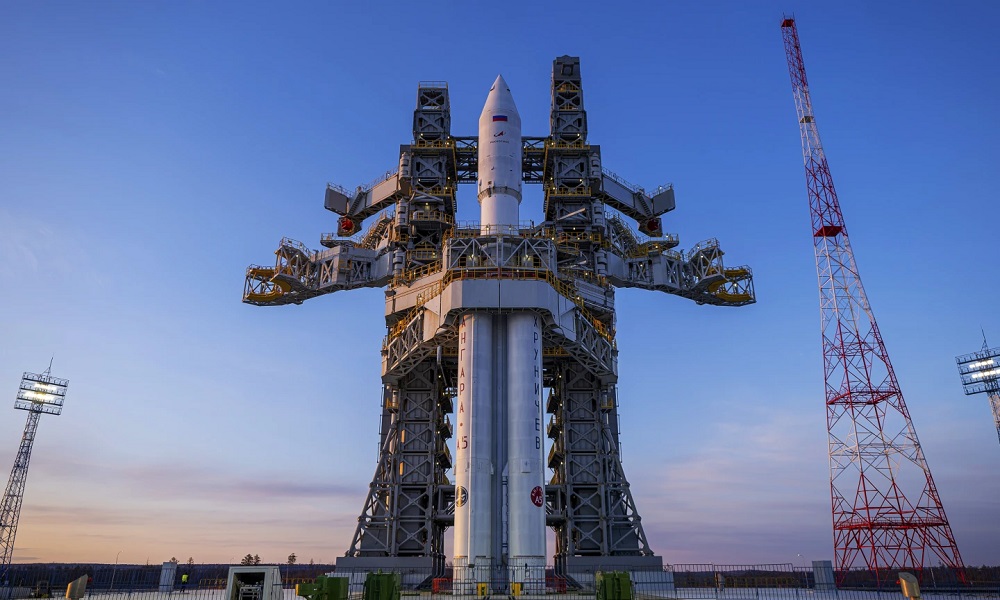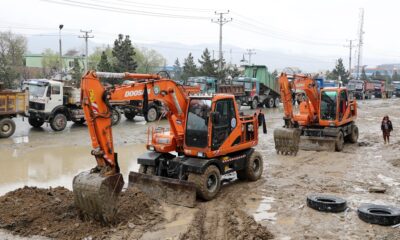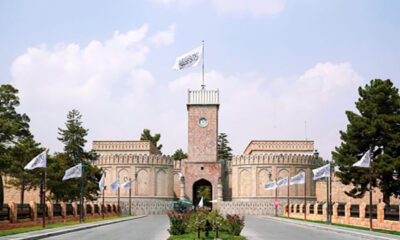Science & Technology
Rock collected by Apollo 17 astronaut in 1972 reveals moon’s age

During the Apollo 17 mission in 1972 – the last time people walked on the moon – U.S. astronauts Harrison Schmitt and Eugene Cernan collected about 243 pounds (110.4 kg) of soil and rock samples that were returned to Earth for further study.
A half century later, crystals of the mineral zircon inside a coarse-grained igneous rock fragment collected by Schmitt are giving scientists a deeper understanding about the moon’s formation and the precise age of Earth’s celestial partner, Reuters reported.
The moon is about 40 million years older than previously thought – forming more than 4.46 billion years ago, within 110 million years after the solar system’s birth, scientists said on Monday, based on analyses of the crystals.
The leading hypothesis for lunar formation is that during the solar system’s chaotic early history a Mars-sized object called Theia slammed into primordial Earth. This blasted magma – molten rock – into space, forming a debris disk that orbited Earth and coalesced into the moon. But the exact timing of the moon’s formation has been hard to nail down.
Mineral crystals were able to form after the magma cooled and solidified. The researchers used a method called atom probe tomography to confirm the age of the oldest-known solids that formed after the giant impact, the zircon crystals inside the fragment of a type of rock called norite collected by Schmitt.
“I love the fact that this study was done on a sample that was collected and brought to Earth 51 years ago. At that time, atom probe tomography wasn’t developed yet and scientists wouldn’t have imagined the types of analyses we do today,” said cosmochemist Philipp Heck, senior director of research at the Field Museum in Chicago, a University of Chicago professor and senior author of the study published in the journal Geochemical Perspectives Letter.
“Interestingly, all the oldest minerals found on Earth, Mars and the moon are zircon crystals. Zircon, not diamond, lasts forever,” UCLA planetary scientist and study co-author Bidong Zhang added.
The rock containing the zircon was collected in the Taurus-Littrow valley at the southeastern edge of the lunar Mare Serenitatis (Sea of Serenity) and stored at NASA’s Johnson Space Center in Houston.
“Zircons are very hard and tough and survive the breakdown of rocks during weathering,” Heck said.
A study led by Zhang published in 2021 used a technique called ion microprobe analysis to measure how many atoms of uranium and lead were in the crystals, calculating the age of the zircon based on the decay of radioactive uranium to lead over time. That age needed to be confirmed through another method because of a potential complication involving lead atoms if defects existed in the zircon crystal structure.
The new study used atom probe tomography to determine there were no complications involving the lead atoms, confirming the age of the crystals.
“I see this as a great example of what the nanoscale, or even atomic scale, can tell us about big-picture questions,” said study lead author Jennika Greer, a cosmochemist at the University of Glasgow in Scotland.
The moon, which orbits Earth at an average distance of about 239,000 miles (385,000 km), has a diameter of about 2,160 miles (3,475 km), a bit more than a quarter of our planet’s diameter.
“The giant impact that formed the moon was a cataclysmic event for Earth and changed Earth’s rotational speed. After that, the moon had an effect on stabilizing Earth’s rotational axis and slowing down Earth’s rotational speed,” Heck said. “The formation date of the moon is important as only after that Earth became a habitable planet.”
“The moon helps stabilize Earth’s axis for a stable climate,” Zhang added. “The moon’s gravitational pulls help shape the ocean’s ecosystem. The moon is inspirational to human cultures and explorations. And NASA and other space agencies see the moon as a steppingstone for future deep-space explorations.”
Science & Technology
Apple loses top phonemaker spot to Samsung as iPhone shipments drop, IDC says

Apple’s (AAPL.O), opens new tab smartphone shipments dropped about 10% in the first quarter of 2024, hurt by intensifying competition by Android smartphone makers aiming for the top spot, data from research firm IDC showed on Sunday.
Global smartphone shipments increased 7.8% to 289.4 million units during January-March, with Samsung (005930.KS), opens new tab, at 20.8% market share, clinching the top phonemaker spot from Apple, Reuters reported.
The iPhone-maker’s steep sales decline comes after its strong performance in the December quarter when it overtook Samsung as the world’s No.1 phone maker. It’s back to the second spot, with 17.3% market share, as Chinese brands such as Huawei gain market share.
Xiaomi, one of China’s top smartphone makers, occupied the third position with a market share of 14.1% during the first quarter, read the report.
South Korea’s Samsung, which launched its latest flagship smartphone lineup – Galaxy S24 series – in the beginning of the year, shipped more than 60 million phones during the period.
Global sales of Galaxy S24 smartphones jumped 8%, compared to last year’s Galaxy S23 series during their first three weeks of availability, data provider Counterpoint previously said.
In the first quarter, Apple shipped 50.1 million iPhones, down from 55.4 million units it shipped same period last year, according to IDC.
Apple’s smartphone shipments in China shrank 2.1% in the final quarter of 2023 from a year earlier.
The drop underscores the challenges facing the U.S. firm in its third biggest market, as some Chinese companies and government agencies limit employees’ use of Apple devices, a measure that mirrors U.S. government restrictions on Chinese apps on security grounds.
The Cupertino, California-based company in June will hold its Worldwide Developers Conference (WWDC), where it will highlight updates to the software powering iPhones, iPads, and other Apple devices.
Investors are closely watching for updates on artificial intelligence development at Apple, which has so far spoken little about incorporating the AI technology into its devices. The company earlier this year lost the crown as the world’s most valuable company to Microsoft (MSFT.O), opens new tab, Reuters reported.
Science & Technology
China launch of relay satellite Queqiao-2 for lunar probe mission successful

China National Space Administration (CNSA) said on Friday its launch of a key signal relay satellite was a “complete success” and it would serve as the communication bridge for its future lunar probe missions for years to come, state media reported.
China launched the satellite Queqiao-2, which was named after a mythological bridge made of magpies, and two miniature satellites, Tiandu-1 and Tiandu-2, on March 20.
Queqiao-2 will be used as a communications bridge between the ground operations on earth and upcoming lunar probe missions on the far side of the moon until at least 2030.
The moon’s near side always faces earth. That means data transfers from the far side are impossible because there is no direct line of sight.
Queqiao-2 researcher and developer Xiong Liang described the satellite as “the main switch” of the whole fourth phase of lunar missions, according to state television CCTV.
“Only when the main switch is flipped on, all the communications can kick off,” Xiong said.
Queqiao-2 will orbit the moon and relay signals to and from the Chang’e-6 mission, which expected to be launched in May. The robotic Chang’e-6 probe will seek to retrieve samples from an ancient basin, acquiring lunar material from the moon’s hidden side for the first time.
Queqiao-2 will also be used as a relay platform for the Chang’e-7 lunar mission in 2026 and the Chang’e-8 mission in 2028.
The functions and performance of Queqiao-2 met mission requirements and it will be able to provide relay communication services for China’s lunar exploration projects and future lunar missions for China and other countries, said the CNSA, according to CCTV.
Queqiao-2 entered its targeted elliptical orbit on April 2 after a correction midway, near-moon braking and orbital manoeuvre around the moon, CNSA said.
The satellite has successfully communicated with Chang’e 4, which was the first spacecraft to perform a soft landing on the far side of the moon and is still carrying out its exploration mission. It also communicated with the Chang’e-6 probe while it is still on the ground earlier this month.
The successful launch of Queqiao-2 comes after the failed launch of another lunar spacecraft DRO-A/B satellites, which was intended to enter the moon’s distant retrograde orbit (DRO).
China has not released any information on whether or not the satellites can be retrieved.
(Reuters)
Science & Technology
Russia aborts planned test launch of new heavy-lift space rocket

Russian space officials on Tuesday aborted the test launch of a new heavy-lift rocket from its far-eastern launch pad.
The Angara-A5 rocket was scheduled to lift off from the Vostochny space launch facility at 0900 GMT Tuesday, but the launch was aborted two minutes before, AP reported.
Yuri Borisov, head of Roscosmos state space corporation, said the automatic safety system canceled the launch after registering a flaw in the oxidizer tank pressurization system.
He said the next launch attempt was set for Wednesday.
Tuesday’s launch was to be the fourth for the Angara-A5, a heavy-lift version of the new Angara family of rockets that has been developed to replace the Soviet-designed Proton rockets.
-

 Latest News4 days ago
Latest News4 days agoRashid Khan named AWCC’s brand ambassador
-

 World4 days ago
World4 days agoMalaysian navy helicopters collide in mid-air, 10 killed
-

 Sport4 days ago
Sport4 days agoJaiswal ton powers Rajasthan to big IPL win
-

 World4 days ago
World4 days agoNorth Korea officials visit Iran in a rare public trip
-

 Latest News5 days ago
Latest News5 days agoAt least 1,500 families affected by recent floods: IRW
-

 Sport4 days ago
Sport4 days agoMawj Sahil player scores stunning halfway line goal in 1-0 win over Jawanan Wahedi
-

 Sport3 days ago
Sport3 days ago‘Serious talent’ Fraser-McGurk bonds with Warner to light up IPL
-

 Latest News4 days ago
Latest News4 days agoUS report cites ‘significant deterioration’ in Afghan women’s rights last year
























